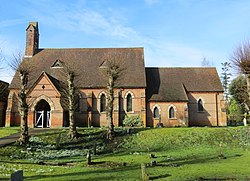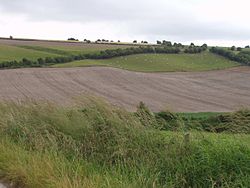Easterton
| Easterton | |
| Wiltshire | |
|---|---|
 Church of St Barnabas, Easterton | |
| Location | |
| Grid reference: | SU021550 |
| Location: | 51°17’38"N, 1°58’16"W |
| Data | |
| Population: | 524 (2011) |
| Post town: | Devizes |
| Postcode: | SN10 |
| Dialling code: | 01380 |
| Local Government | |
| Council: | Wiltshire |
| Parliamentary constituency: |
Devizes |
Easterton is a village in Wiltshire, at the northern edge of Salisbury Plain four miles south of Devizes. The wider parish includes the hamlets of Easterton Sands and Eastcott.
Geography
The parish includes gault and greensand north-west of the road, and lower, middle and upper chalk zones ascending the slope south-eastwards on to the high plain. Across the parish runs The Ridgeway, an ancient route, along the scarp. The railway runs through too, north of the greensand ridge, and the former turnpike road in between. This forms the village street, where it is bordered on the west side by a small brook. The street is in a hollow, so that gardens on the east side rise very steeply and have been terraced up the slope. Paths and lanes lead off the street to 'the Clays' on the east and 'the Sands' on the west. The main streets in the village are Oak Lane, Haywards Place, High Street, White Street, the Clay, Kings Road and Vicarage Lane.
History

Easterton is the site of a Roman villa estate, known from stray archaeological finds in the area of Kestrels in Oak Lane, west of the village. This may be linked with a mid-4th century Roman coin hoard, discovered in an urn during the 19th century and dispersed[1] (although some coins passed to the Wiltshire Museum, Devizes). Another possible Roman site, deduced from place-name evidence, may lie at Wickham Green on the boundary with Urchfont a mile or so north of Kestrels.
The name of Easterton is from the Old English for "easterly farm". It was a tithing which formed the eastern part of the ancient parish of East Lavington, now Market Lavington. Easterton was made a separate civil parish soon after its ecclesiastical parish was created in 1874, and in 1934 Eastcott hamlet was transferred to it from Urchfont parish.[2]
The parish has three concentrations of buildings: around Easterton Manor House and the Royal Oak inn; near the Victorian parish church; and at Eastcott along a secondary road (B3098) and interspersed with modern housing. Some older houses were lost as a result of road widening in the later 20th century. A map of 1773 suggests that there were then more buildings at Eastcott, and between Eastcott and Easterton than at present, and therefore that the settlements have declined. The survival of timber-framed houses in separate groups in an area where from the 18th century brick buildings have predominated is consistent with such a decline.
A school opened at Easterton in 1865, moved to a new building in 1876, and later became a National School. The school closed in 1971, along with the Victorian school at Market Lavington, and pupils from both parishes transferred to a new school, now called St Barnabas CofE Primary School, in Market Lavington parish near the boundary with Easterton.[3]
Market gardening and fruit growing by smallholders on the fertile soils of the greensand became important as the traditional sheep and corn husbandry on the chalk ('the Clays') declined following enclosures before 1800. Samuel Moore's jam factory was a legacy of the fruit fields. It began in a small way early in the 20th century after an earlier venture had closed, and became a major employer in the area, with 100 staff in 1972. An extension was opened in 1985, but the whole enterprise closed during the 1990s, and visitors to the village are no longer greeted by the all-pervading aroma of warm strawberry jam.[1]
Churches
Until 1874 when Easterton became a separate ecclesiastical parish, it was a tithing of St Mary's, Market Lavington.[2]
The parish church of St Barnabas was built in 1875, in red brick with coloured brick decoration.[4] Today the church is part of the benefice of the Lavingtons, Cheverells and Easterton.[5]
A Wesleyan Methodist chapel was built at Easterton in 1868. It was sold and became a private house in 1985.[6]
Eastcott had a small chapel by 1309, which passed to Edington Priory later in the century. The chapel fell into disuse after the 1548 Dissolution and its location is not known.[7]
Sights about the village

Easterton has one pub, the Royal Oak; a 17th-century thatched building.[8] There is a village hall too.
Eastcott Manor is a Grade II* listed farmhouse of c. 1600, extended in the later 17th century and in the 18th.[9]
Kestrels is an early 18th century brick house in the village, and is also Grade II*-listed.[10]
Wroughton's Folly was a mansion in the far northwest of the parish, close to the modern boundary with Urchfont parish. It was built and enlarged by two members of the Wroughton family, Francis and Seymour, between about 1730 and 1780. After Seymour's accidental death in 1789 the house was left unoccupied and became a ruin. Its foundations, visible in the 19th century, have now disappeared. Seymour's death came by a furious carriage ride along the house's driveway, now vanished – to which local legend has of course added a ghost story.[1][11]
Outside links
| ("Wikimedia Commons" has material about Easterton) |
References
- ↑ 1.0 1.1 1.2 "Easterton". Wiltshire Council. https://history.wiltshire.gov.uk/community/getcom2.php?id=87. Retrieved 9 August 2016.
- ↑ 2.0 2.1 A History of the County of Wiltshire - Volume 10 pp 82-106: {{{2}}} (Victoria County History) - Parishes: Market Lavington. British History Online
- ↑ "Easterton School". Wiltshire Council. https://history.wiltshire.gov.uk/community/getschool.php?id=1337. Retrieved 9 August 2016.
- ↑ "Church of St. Barnabas, Easterton". Wiltshire Council. https://history.wiltshire.gov.uk/community/getchurch.php?id=1301. Retrieved 9 August 2016.
- ↑ [St Barnabas Church, Easterton
- ↑ "Wesleyan Methodist Chapel, Easterton". Wiltshire Council. https://history.wiltshire.gov.uk/community/getchurch.php?id=1303. Retrieved 9 August 2016.
- ↑ A History of the County of Wiltshire - Volume 10 pp 173-190: {{{2}}} (Victoria County History) - Parishes: Urchfont. British History Online
- ↑ National Heritage List 1035818: The Royal Oak
- ↑ National Heritage List 1284568: Eastcott Manor
- ↑ National Heritage List 1364630: Kestrels
- ↑ "The Folly". Market Lavington Museum. October 2011. https://marketlavingtonmuseum.wordpress.com/2011/10/29/the-folly/. Retrieved 9 August 2016.
